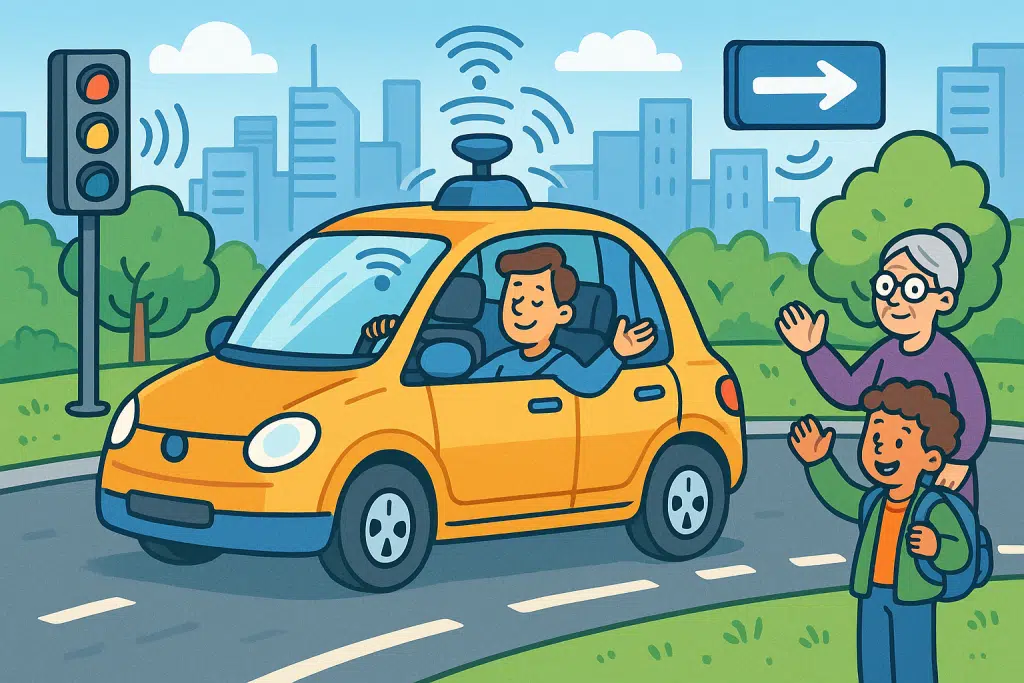The Future of Autonomous Vehicles and Its Impact on Society
Ethan Harris August 12, 2025
The future of autonomous vehicles is no longer sci-fi fantasy—it’s cruising around your city, collecting data, dropping people off, and sparking public debates. This post dives into the rapid rise of robotaxis (yes, that’s the current hot trend), how they’re impacting society today, and what lies ahead. We’re talking real deployments, regulatory tug-of-wars, economic shake-ups, and the tech behind it. Ready? Let’s roll.

1. Robotaxis Go Live: Real-World Rollouts Taking Over Streets
The robotaxi revolution isn’t coming—it’s already here, transforming urban transportation across multiple cities. What started as experimental pilots has evolved into full-scale commercial operations reshaping how people get around.
Waymo Leads the Charge
Waymo is scaling rapidly, offering commercial robotaxi service in cities like San Francisco, Los Angeles, Phoenix, Austin (via Uber), and parts of Silicon Valley. They’re even prepping to launch in Washington, D.C., and Japan. With over 20 million autonomous miles logged and completely driverless operation, Waymo has the most mature technology stack in the industry, using LiDAR, cameras, and radar for redundant safety systems.
Tesla’s Camera-Only Gamble
Tesla just launched a pilot in Austin—10 Model Y vehicles on a small route charging 4.20 US dollars a ride, monitored by humans in the passenger seat. Their controversial approach relies entirely on cameras and computer vision, no LiDAR. Texas regulators handed Tesla a permit to run robotaxi services statewide, but full driverless certification still needs DMV approval by September 1, 2025. If Tesla’s vision-only system works, it could dramatically reduce costs and make robotaxis economically viable at scale.
The Platform Wars
Uber isn’t sitting still—they plan to deploy 20,000 autonomous taxis over six years, partnering with Lucid and Nuro to upend the robotaxi wars. Rather than building their own tech, they’re leveraging existing platforms and their massive user base.
Lyft is pushing their own fleet, working with May Mobility, Mobileye, Baidu, and others to get driverless pilot shuttles rolling in cities like Atlanta, Dallas, Germany, and the UK. Both companies are hedging their bets across multiple autonomous driving technologies.
Market Reality
These aren’t just tech demos anymore—they’re real businesses serving paying customers daily. Cities are adapting infrastructure with new pickup zones and traffic management systems, while regulators balance innovation with safety. The global robotaxi market is projected to reach hundreds of billions by 2030, with early movers positioned to capture outsized returns.
Bottom line: the future of autonomous vehicles is here—and robotaxis are leading the charge into public roads, setting the stage for a fundamental transformation in urban mobility.
2. Why Robotaxis Matter—Society, Economy, and Beyond
A) Convenience, Time, and the Einstein Effect
Imagine catching rides for as low as 25 US dollars instead of 100 US dollars —without talking to a driver. Uri Levine, Waze co-founder, says kids born today (Gen Beta) won’t drive; autonomy will dominate transit, retail gone mobile, and your commute time becomes you time.
B) Economic Boom—and Big Disruption
- Global robotaxi and autonomous vehicle revenue is exploding—from around 208 billion US dollars in 2023 to an expected 428 billion US dollars by 2025—and projected to surge into the trillions within the decade.
- But this shift could also shutter jobs. Nearly 2.9 million roles (think truckers, taxi drivers, bus operators) in the U.S. alone are at risk.
C) Trust, Safety, and Regulatory Maze
Despite progress, consumer trust is still modest. Real-world experience, transparency, and spotless safety records are the only way forward.
Texas is one of the few chill regulatory battlegrounds—otherwise, robotaxis are grappling with massive legal, safety, and business-model hurdles.
3. Tech Talk: What Powers a Robotaxi?
It’s not just about cool lasers and AI—it’s a layered mixtape of tech:
- Sensor wars: Waymo leans on LIDAR, radar, and cameras; Tesla goes camera-only and relies on neural-net smarts, which some critics say is riskier.
- AI acceleration: A new startup, DensityAI, led by ex-Tesla Dojo engineers, is building an all-in-one AI platform to train and deploy self-driving systems faster across the auto industry.
- Global software-defined vehicles: Partnerships like WeRide with Tencent Cloud are pushing fully driverless tech into airports, buses, robotaxis across China, Europe, and the Middle East.
4. Social Ripple Effects: Not Just Roads, but Cities and Lives
Urban Layout & Environment
Full robotaxi adoption could mean fewer private cars, repurposed parking lots, less pollution, and a smoother ride overall. Though big gains may only hit in the 2040s–2060s when these vehicles become common and affordable.
Equity & Accessibility
Robotaxis could improve mobility for people with disabilities or underserved urban areas—but if design isn’t inclusive, they may leave vulnerable groups behind.
Cybersecurity & Privacy
China is already pushing new vehicle cybersecurity standards—monitoring anomalies, managing data export rules, demanding robust systems. Similar frameworks are emerging globally.
5. Quick Table: Robotaxi Snapshot
| Category | Highlights |
|---|---|
| Deployments | Waymo expanding; Tesla piloting; Uber/Lyft scaling fast |
| Tech | Lidar vs. camera; AI platforms like DensityAI; software-defined cars |
| Impact | Time saved, economic disruption, job displacement |
| Challenges | Trust, regulation, job loss, infrastructure, cybersecurity |
| Future Outlook | Likely consumer mainstream by late 2020s; full societal benefits post-2040s |
6. What’s Coming Next—and What You Can Do
Rider Tips
Start paying attention—the next ride you book might literally drive itself (spoiler: that’s both thrilling and nerve-wracking). And hey, demand transparency in safety scores and machine-learning protocols.
Policy Pushes
If you’re fired up as a citizen or writer, advocate for inclusive, equitable tech—push decision-makers to think beyond downtown glossy districts.
Content Creator Angle
As a content pro (ahem, Gabby), here’s your win: storylines around real user experiences, displacement solutions, ethical programming, cybersecurity, and green city retooling are gold for engagement—and search share.
Final Thoughts: Robotaxi Love Story—or Tension?
We’re not just witnessing futuristic gadgets—we’re living a transition. Robotaxis are charting paths through our streets, laws, wallets, and well, imaginations. Their rollout is messy, unpredictable, and, yes, thrilling. Yet they demand accountability: from manufacturers, regulators, and citizens alike.
Enjoy the ride, but keep your eyes open. And hey, tell that to Gen Beta: driving is so last century
References
- Gherardini, L., & Cabri, G. (2024).The Impact of Autonomous Vehicles on Safety, Economy, Society, and Environment.World Electric Vehicle Journal, 15(12), 579. https://doi.org/1
- Kim, T. J. (2018).Automated Autonomous Vehicles: Prospects and Impacts on Society.Journal of Transportation Technologies, 8, 137–150. https://doi.org/
- McCarroll, C. (2022).Social Implications of Autonomous Vehicles: A Focus on Time.PMC (NCBI). https://www.ncbi.nlm.nih.gov/







